|
Featured picture tools: |
These featured pictures, as scheduled below, appeared as the picture of the day (POTD) on the English Wikipedia's Main Page in April 2019. Individual sections for each day on this page can be linked to with the day number as the anchor name (e.g. [[Wikipedia:Picture of the day/April 2019#1]] for April 1).
You can add an automatically updating POTD template to your user page using {{Pic of the day}} (version with blurb) or {{POTD}} (version without blurb). For instructions on how to make custom POTD layouts, see Wikipedia:Picture of the day.Purge server cache
April 1

|
Sir Nils Olav, colonel-in-chief of the Norwegian Army's King's Guard, inspects his troops in 2008. Olav was inducted into the army in 1972 with the rank of lance corporal, and has received a series of promotions since then as well as a knighthood. As of 2019 he holds the rank of brigadier. The name Nils Olav, and its associated ranks, have been used by three king penguins over the years, all resident at Edinburgh Zoo. The animal pictured is the second. His military insignia is attached to his flipper. Photograph: Mark Owens |
April 2

|
Eugen Sandow (2 April 1867 – 14 October 1925) was a German bodybuilder and showman. Born in Königsberg, Sandow became interested in bodybuilding at the age of ten during a visit to Italy. He studied under strongman Ludwig Durlacher in the late 1880s and, on Durlacher's recommendation, performed in a series of matches against leading figures in the sport such as Charles Sampson and Henry McCann. In 1901 he organised what is believed to be the world's first major body building competition. Set in London's Royal Albert Hall, Sandow judged the event alongside author Arthur Conan Doyle and athlete/sculptor Charles Lawes-Wittewronge. This picture shows an 1894 poster advertising the Sandow Trocadero Vaudevilles, a show featuring Sandow and produced by Florenz Ziegfeld Jr.. Poster: Strobridge Lithographic Company; Restoration: Adam Cuerden
Recently featured:
|
April 3

|
An oil platform in Mittelplate, the largest oil field in Germany. The field is located in the North Sea, around 7 km (4.3 mi) from the shore, in the tidal flats of the Schleswig-Holstein Wadden Sea National Park. It was discovered in 1980 and 1981 when test borings in the Mittelplate vicinity found oil in several sandstone layers. Due to the location of the field in an ecologically sensitive area it was subjected to hydrographic, hydrodynamic and meteorological studies to model storm, wave, and ice-flow conditions. The results led to the construction of an artificial island in 1985, which holds a drilling and production facility. By the 20th anniversary of the start of production, 20 million tonnes of crude had been produced from the field. Photograph: Ralf Roletschek
Recently featured:
|
April 4

|
Madonna and Child with Angels is the central panel of the large multi-paneled altarpiece produced by Masaccio for the chapel of Saint Julian in the church of Santa Maria del Carmine in Pisa, Italy. The panel, which is badly damaged and smaller than its original size, was produced in collaboration with Masaccio's brother Giovanni and with Andrea di Giusto in 1426. It depicts six figures: the Madonna, Child, and four angels. The Madonna is the centre figure and is larger than any of the others to signify her importance. Christ sits on her knees, eating grapes offered to him by his mother. The grapes represent the wine which was drunk at the Last Supper, symbolising Christ's blood. Madonna and Child with Angels is now in the collection of the National Gallery in London. Paiting: Masaccio
Recently featured:
|
April 5

|
Elk Bath is a wildlife photograph by John McColgan, a fire behavior expert working for the Alaska Fire Service division of the US Bureau of Land Management. It was taken on August 6, 2000, on the East Fork of the Bitterroot River on the Sula complex in the state of Montana. The picture shows two elk seeking protection from a raging wildfire by standing in the river. It was one of the Time magazine Photos of the Year 2000. McColgan took the picture with a Kodak DC280 digital camera. Photograph: John McColgan
Recently featured:
|
April 6
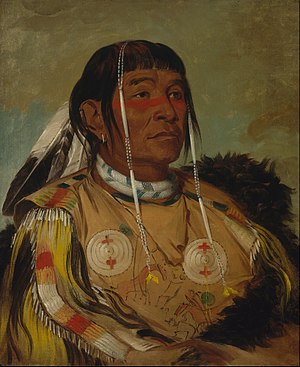
|
Sha-có-pay is an oil-on-canvas painting from life by American artist George Catlin. It depicts an indigenous American named Sha-có-pay (which means "The Six" in the Dakota language), who was chief of the Plains Ojibwe. Catlin traveled throughout Western North America, painting indigenous peoples at a time when the only contact with Europeans was from explorers and traders. The painting shows traditional Plains Ojibwe clothing such as a beaded buckskin shirt, a buffalo-hide robe, eagle feathers, hair pipes, and a beaded necklace that is found only among the tribes of the northernmost plains, the Ojibwe and the Cree. The portrait was painted by the artist during a trip to Fort Union in 1832. It now resides in the Smithsonian American Art Museum in Washington, D.C. Painting: George Catlin
Recently featured:
|
April 7
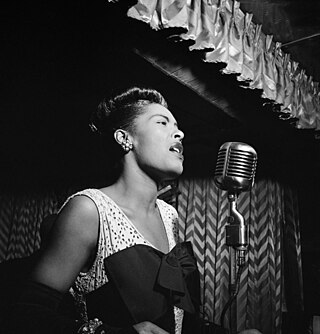
|
Billie Holiday, real name Eleanora Fagan (April 7, 1915 – July 17, 1959), was an American jazz and pop singer whose career spanned nearly thirty years. Nicknamed "Lady Day" by her friend and music partner Lester Young, Holiday was known for her vocal delivery and improvisational skills, which made up for her limited range and lack of formal music education. Photograph: William P. Gottlieb, restoration: Kaldari
Recently featured:
|
April 8

|
Rootabaga Stories is a children's book of interrelated short stories by Carl Sandburg, written in 1922. The stories are whimsical and sometimes melancholy, making use of nonsense language. Rootabaga Stories was originally created for Sandburg's own daughters, Margaret, Janet and Helga—whom he nicknamed "Spink", "Skabootch", and "Swipes"—and those nicknames occur in some of the Rootabaga stories. The book was born of Sandburg's desire for fairy tales to which American children could relate, rather than the traditional European stories involving royalty and knights. He therefore set the book in a fictionalized American Midwest called the "Rootabaga country", in which fairy-tale concepts were mixed with trains, sidewalks, and skyscrapers. This picture shows the frontispiece of the 1922 edition of the book. Illustration: Maud and Miska Petersham; restoration: Adam Cuerden
Recently featured:
|
April 9

|
Oath of the Horatii is a large painting by the French artist Jacques-Louis David painted in 1784. It depicts a scene from a Roman legend about a seventh-century BC dispute between two warring cities, Rome and Alba Longa. Instead of the two cities sending their armies to war, they agree to choose three men from each city; the victor in that fight will be the victorious city. From Rome, three brothers from a Roman family, the Horatii, agree to end the war by fighting three brothers from a family of Alba Longa, the Curiatii. The three brothers, all of whom appear willing to sacrifice their lives for the good of Rome, are shown saluting their father, who holds their swords out for them. The principal sources for the story behind David's Oath are the first book of Livy, as elaborated by Dionysius of Halicarnassus. However, the moment depicted in David's painting is his own invention. The painting led to the popularization of the Roman salute and also increased David's fame, allowing him to take on his own students. It is now in the Louvre in Paris. Painting: Jacques-Louis David
Recently featured:
|
April 10

|
A promotional flyer for Supir Istimewa ("Special Chauffeur"), a 1954 black-and-white Indonesian film directed by Rempo Urip and produced by Djamaluddin Malik for the Persari Film Corporation. Starring MS Priyadi, Ermina Zaenah, Abdul Hadi, and Djauhari Effendi, the film follows a wealthy young man who passes as a chauffeur to convince a village woman to fall in love with him. The film was based on a screenplay by Saleh Iskandar Rais. Artwork: Employee(s) of Persari Film Corporation; restored by Chris Woodrich
Recently featured:
|
April 11
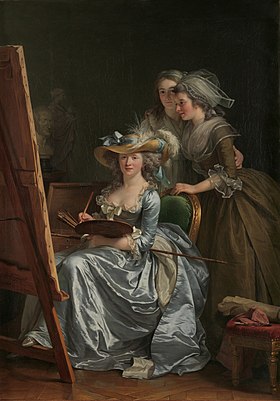
|
Self-Portrait with Two Pupils is a 1785 self-portrait painting by French artist Adélaïde Labille-Guiard. It depicts the artist with two of her pupils, Marie Gabrielle Capet and Marie-Marguerite Carreaux de Rosemond. Born in Paris on 11 April 1749, Labille-Guiard grew up in a neighbourhood of artists and, on her own initiative, began painting and receiving training from them. She began to take students of her own in 1780. They were all female and she was an advocate for women's involvement in painting. Labille-Guiard spent considerable time planning Self-Portrait with Two Pupils—she produced a chalk study during this period in which she was investigating the closeness and the effect of the light on the students' heads. The finished painting is almost life-size and it has been speculated that the artist and one of the pupils are looking at a mirror. In this case Labille-Guiard is actually painting the very painting the observer sees. The painting is now in the collection of the Metropolitan Museum of Art. Painting: Adélaïde Labille-Guiard
Recently featured:
|
April 12
Subpage 1

|
The French franc is a former currency of France and Monaco and, alongside the Spanish peseta, a former de facto currency in Andorra. The first franc was a gold coin introduced in 1360, which showed King John II of France on a richly decorated horse, earning it the name franc à cheval. A later coin, showing Charles VII on foot, under a canopy, was named the franc à pied. The decimal franc was established by the French Revolutionary Convention in 1795 as a decimal unit, and became the official currency of France in 1799. France joined the euro in 1999, and the franc was replaced by euro notes and coins in 2002. This picture shows a 20-franc coin, dated 1803. The obverse shows an image of Napoleon. See also: 1807 40-franc coin Coin: Monnaie de Paris, Republic of France; Image: National Numismatic Collection, National Museum of American History
Recently featured:
|
Subpage 2

|
The French franc is a former currency of France and Monaco and, alongside the Spanish peseta, a former de facto currency in Andorra. The first franc was a gold coin introduced in 1360, which showed King John II of France on a richly decorated horse, earning it the name franc à cheval. A later coin, showing Charles VII on foot, under a canopy, was named the franc à pied. The decimal franc was established by the French Revolutionary Convention in 1795 as a decimal unit, and became the official currency of France in 1799. France joined the euro in 1999, and the franc was replaced by euro notes and coins in 2002. This picture shows a 40-franc coin, dated 1807. The obverse shows an image of Napoleon. See also: 1803 20-franc coin Coin: Monnaie de Paris, Republic of France; Image: National Numismatic Collection, National Museum of American History
Recently featured:
|
April 13

|
A Session of the Painting Jury is an oil-on-canvas painting by the French artist Henri Gervex, probably undertaken in 1885. The painting shows a meeting of the Paris Salon, the official exhibition of the Académie des Beaux-Arts, in a room on the first floor of the Palais de l'Industrie in 1883. It was itself exhibited at the Salon in 1885. Several artists of the time are identifiable in the painting including Félix-Joseph Barrias, Jean-Joseph Benjamin-Constant, Léon Bonnat, William-Adolphe Bouguereau, Alexandre Cabanel, Carolus-Duran, Gustave Achille Guillaumet and Antoine Vollon, who are involved in judging the works of art shown. A Session of the Painting Jury was designated a piece of official art during the Third Republic and has been in the collection of the Musée d'Orsay in Paris since 1981. Painting: Henri Gervex
Recently featured:
|
April 14

|
A map of the French city of Brest, dated to around 1700. Located in the Finistère department of Brittany, Brest lies in a sheltered bay close to the western extremity of metropolitan France. Originally named Bresta, possibly derived from a Celtic word meaning hill, the city came under the rule of the duke of Brittany in 1240. From 1342 to 1397 the city was under English rule, and became part of France in 1491 when a marriage unified Brittany with the French crown. Cardinal Richelieu designated the city a major naval base in 1631, a status it retains today. The city centre was mostly rebuilt after heavy Allied bombing during World War II. Map: Unknown; Restoration: S. Déniel
Recently featured:
|
April 15
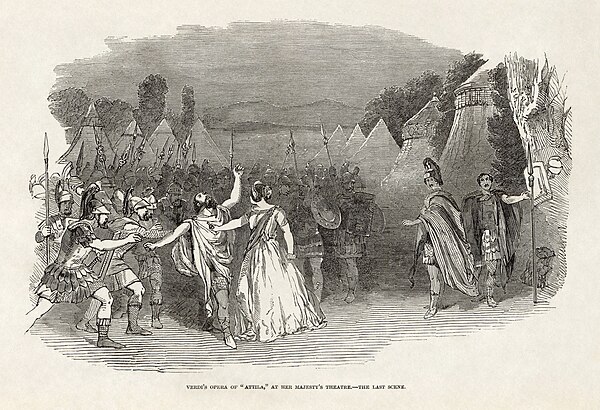
|
|
An illustration from The Illustrated London News, dated 15 April 1848, showing the last scene in Giuseppe Verdi's opera Attila performed at Her Majesty's Theatre in London, two years after its premiere in Venice. The London performances were produced by the impresario Benjamin Lumley, who later noted that "none perhaps of Verdi's works had kindled more enthusiasm in Italy or crowned the fortunate composer with more abundant laurels than Attila". In the final scene the captured Odabella, daughter of the Lord of Aquileia, stabs and kills Attila with a sword, to avenge the death of her father at Attila's hands. Illustration: Uncredited · Restoration: Adam Cuerden
Recently featured:
|
April 16

|
The collared whitestart (Myioborus torquatus), also known as the collared redstart, is a tropical New World warbler endemic to the mountains of Costa Rica and western-central Panama. It is common at heights between 1,500 metres (5,000 ft) and the timberline in mossy mountain forests, ravines, second growth, and adjacent pastures. The collared whitestart is around 13 centimetres (5 in) in length with a weight of 10.5 grams (0.4 oz). It has a chestnut crown bordered with black, and a black forehead. The rest of the upperparts are slaty black, and the tail is black with white edges. The face and underparts are bright yellow, with a black band across the breast. Photograph: Simon Pierre Barrette
Recently featured:
|
April 17

|
The Conversion of Mary Magdalene is an oil painting by the Italian Renaissance artist Paolo Veronese. Dating from around 1545–1548, the painting was commissioned by a noble patron in Verona. The subject of the painting has been debated but the current consensus among scholars is that it depicts the conversion of Mary Magdalene. In the legend that inspired the painting, Mary went to a temple where the teachings of Jesus inspired her to convert to a pious life. She is depicted by Veronese in dress inappropriate for the religious building, which Veronese used to symbolise her prior sinful life. She is shown on her knees and blushing as she listens to Jesus. The painting now hangs in the National Gallery in London. Painting: Paolo Veronese
Recently featured:
|
April 18

|
Point Vicente Light is a lighthouse in Rancho Palos Verdes, California, north of Los Angeles Harbor. It is 67 feet (20 m) tall and stands on a cliff with a height of 130 feet (40 m). The lighthouse was built in 1926 using a Parisian Fresnel lens with a width of 5 feet (1.5 m), which had been in use in Alaska since its construction in 1886. The light was dimmed during World War II to prevent it being used by enemy ships, and in 1971 it was automated. The lighthouse is managed by the United States Coast Guard and is not usually open to the public, except for monthly tours and the annual "Whale of a Day" festival. Photograph: Mquach
Recently featured:
|
April 19

|
|
The Denial of Peter refers to three denials of Jesus by the Apostle Peter, as described in the Bible. All four Gospels of the New Testament state that during Jesus' Last Supper with his disciples, he predicted that Peter would deny knowledge of him before the rooster crowed the next morning. According to the narrative the prediction came true when, following the arrest of Jesus, Peter denied knowing him three times. After the third denial, Peter heard the rooster crow and recalled the prediction, causing him to cry bitterly. This picture is an oil-on-canvas painting by Gerard Seghers, depicting the Denial of Peter. It dates to around 1620–1625 and is now held by the North Carolina Museum of Art. Painting: Gerard Seghers
Recently featured:
|
April 20
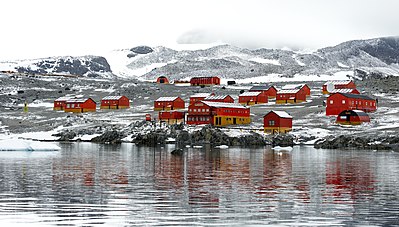
|
Esperanza Base, established in 1953, is one of Argentina's 13 Antarctic research bases, located in Hope Bay on the Trinity Peninsula of the larger Antarctic Peninsula. It contains 43 buildings with 3,744 square metres (40,300 sq ft) of space. In 1978, a pregnant woman was flown there for the birth of her child, Emilio Palma, the first in Antarctica. Photograph: Godot13
Recently featured:
|
April 21

|
Resurrection is an oil-on-canvas painting by Italian artist Cecco del Caravaggio (also known as Francesco Buoneri), produced in 1619–20. Depicting Christ's resurrection on Easter Sunday, it was commissioned in 1619 for Piero Guicciardini, the Tuscan ambassador to Rome, for his private chapel in Santa Felicita, Florence. Painting: Cecco del Caravaggio
Recently featured:
|
April 22
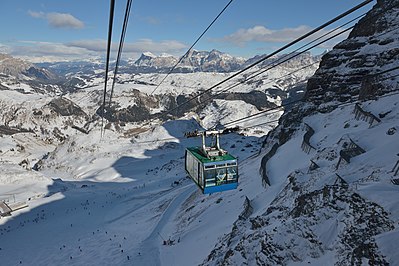
|
A Funifor is a type of cable car with two guide ropes, patented by the Doppelmayr Garaventa Group. Two reversible cabins run on parallel tracks and, unlike other types of aerial tramway, the two drives for the two cabins are not interconnected. At the top of each track the haul rope for that track loops back to the bottom instead of looping over to serve the other track. This feature allows for single-cabin operation when traffic warrants. The independent drive also allows for evacuations to occur by means of a bridge connected between the two adjacent cabins. The Funifor system is stable in high wind conditions owing to the horizontal distance between the two guide ropes comprising each track. This picture shows a Funifor in the Arabba-Porta Vescovo ski resort in Italy. Photograph: Wolfgang Moroder
Recently featured:
|
April 23

|
James Buchanan (April 23, 1791 – June 1, 1868) was the 15th president of the United States (1857–1861), serving immediately prior to the American Civil War. A member of the Democratic Party, he was the 17th United States Secretary of State and had served in the Senate and House of Representatives before becoming president. Buchanan wished and aspired to be a president who would rank in history with George Washington, by using his tendencies toward neutrality and impartiality. Historians fault him, however, for his failure to address the issue of slavery and the secession of the southern states, and they commonly rank him as one of the worst presidents in American history. Engraving: Bureau of Engraving and Printing; restoration: Andrew Shiva
Recently featured:
|
April 24
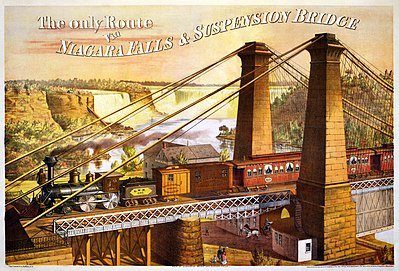
|
An 1876 advertisement for the Great Western Railway for travel via the Niagara Falls Suspension Bridge, the world's first working railway suspension bridge, which connected Niagara Falls, Ontario, Canada, to Niagara Falls, New York, United States. The bridge was operational from 1855 to 1897, and was replaced by the Whirlpool Rapids Bridge. Image credit: Clay, Cosack & Co.
Recently featured:
|
April 25

|
A row of terraced houses on Bathwick Hill in the city of Bath. Like much of the city the houses are built using the local golden-coloured Bath stone, a type of limestone. Located in south-west England, Bath is notable for its baths fed by three hot springs. It was first recorded as a Roman spa and temple named Aquae Sulis, although archaeological evidence suggests that the main spring of the baths may have been treated as a shrine by the Britons before the Roman invasion. From Elizabethan to Georgian times it was a resort city for the wealthy. As a result of its popularity during the latter period, the city contains many fine examples of Georgian architecture, particularly the Royal Crescent. Photograph: David Iliff
Recently featured:
|
April 26
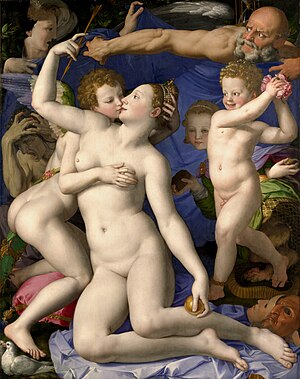
|
Venus, Cupid, Folly and Time is an oil-on-wood allegorical painting by the Florentine artist Agnolo Bronzino, created in around 1545. Scholars do not know for certain what the painting depicts, but the two central figures are recognisable as Venus and Cupid. The bearded, bald figure to the upper right of the scene, shown in front of an hourglass, is believed to be Time, and there are several theories regarding the identity of the other characters. The painting is now in the National Gallery, London. Painting: Agnolo Bronzino
Recently featured:
|
April 27

|
|
Fairy chimney rock formation in the Göreme National Park, close to the town of Göreme. Situated in the Turkish historical region of Cappadocia, Göreme has a population of around 2,000 people. It is not known when it was first inhabited, but there was a settlement there during the Hittite era, between 1800 and 1200 BC. For many centuries, the location was central between rival empires, leading the natives to tunnel into the rock to escape the political turmoil. During the Roman era, the area became home to Christians retreating from Rome. The Göreme valley was designated a UNESCO World Heritage Site in 1985. Photograph: Benh Lieu Song; retouch: Thomas Wolf
Recently featured:
|
April 28

|
The historical coat of arms of the U.S. state of Maryland from 1876. One of the original British Thirteen Colonies, Maryland was founded by George Calvert, a Catholic convert. It was named in honor of Henrietta Maria of France, wife of Charles I of England. It was admitted to the Union on April 28, 1788, after ratifying the new federal Constitution. Although one of the smallest American states, it has a variety of climates and topographical features that have earned it the moniker of "America in Miniature". Sixteen of Maryland's twenty-three counties and its largest city, Baltimore, border the tidal waters of the Chesapeake Bay estuary. Illustration: Henry Mitchell; restoration: Andrew Shiva
Recently featured:
|
April 29

|
A Winter Scene with Skaters near a Castle is an oil-on-oak painting undertaken between 1608 and 1609 by the Dutch artist Hendrick Avercamp. As with a number of Avercamp's works, the picture is part of the Flemish tradition of painting "the harmony of human activity and the cycle of nature". He was influenced in his subject by the Little Ice Age, particularly the cold winter of 1607–08, and was the first of the Dutch painters to specialise in snow scenes. The painting was acquired by the National Gallery in London in 1891 and remains in its collection today. On acquisition it was square in shape, but during cleaning in 1983 it was established that Avercamp's original was circular, and the surrounding pieces were made by another artist. The gallery removed the additions. Painting credit: Hendrick Avercamp
Recently featured:
|
April 30

|
Messier 81, also known as Bode's Galaxy, is a spiral galaxy about 12 million light-years away in the constellation Ursa Major. It is about half the size of the Milky Way, with a diameter of 90,000 light years. Discovered by Johann Elert Bode on December 31, 1774, it has been studied extensively by astronomers due to its proximity, large size, and active galactic nucleus. Messier 81 can be viewed easily using binoculars and small telescopes, and under exceptional viewing conditions can be seen with the naked eye. The center of the galaxy has a supermassive black hole with around 70 million times the mass of the Sun. Photograph credit: Ken Crawford
Recently featured:
|
Picture of the day archives and future dates